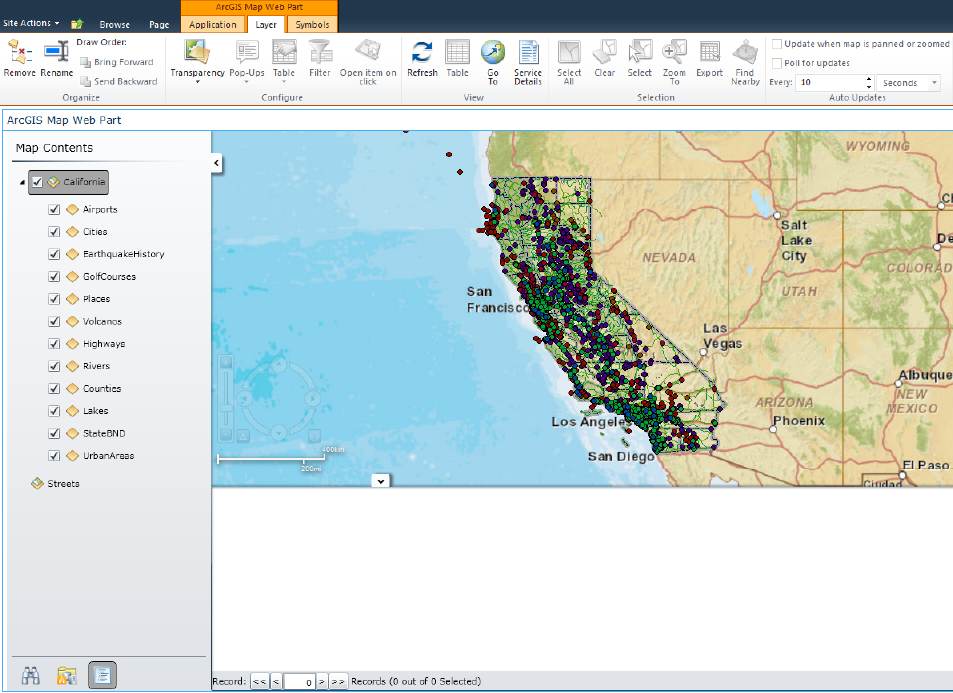The ArcGIS Map Web Part can display layers on the map that come from many different sources. The capabilities of a layer depends on the type of the source it was added from. The different layer types and the capabilities of each are described below.
ArcGIS Server Map Services
When an ArcGIS Server Map Service is added to the map, the application retrieves and displays image tiles from the service. The image tiles do not contain any information about the features they show. For this reason, the rendering performance of this type of layer is very good, but its configuration options are limited.
Example URL: http://serverapps.esri.com/arcgis/rest/services/California/MapServer
Behavior:
- Service is selectable in Map Contents
- Attribute table is not populated
- Limited configuration options (notice the number of disabled buttons on the Layer tab of the ribbon)
- If the service is dynamic, the layers contained by the service are shown in Map Contents. These layers:
- Cannot be selected (i.e. made the active layer)
- Can be toggled on and off by clicking the checkbox next to them

Layers within ArcGIS Server Dynamic Map Services
Through the Browse panel, you have the option to add individual layers within ArcGIS Server Dynamic Map Services to the map. When one of these layers is added to the map, the application retrieves the data for the features that the layer contains from the server and draws them as graphics on the client. For this reason, this layer type provides a wide range of configuration options, but its rendering performance is not as good as that of layers created from map or image services.
Example URL: http://serverapps.esri.com/ArcGIS/rest/services/California/MapServer/1
Behavior:
- Attribute table is populated
- Layer can be selected in Map Contents
- Pop-Ups are present when using mouse to hover over features
- Features are selectable
- Layer symbology can be configured

ArcGIS Server Spatial Data Service (SDS) layers
The Browse panel also provides the option to add tables from an SDS endpoint to the map. When one of these layers is added, the web part retrieves the data for the records that the table contains and draws them as graphics on the client. For this reason, this layer type provides a wide range of configuration options, but its rendering performance is not as good as that of layers created from map or image services.
Example URL: http://serverapps.esri.com/sds/databases/Demo/dbo.USCities_Mercator
Behavior:
- Attribute table is populated
- Can be toggled on and off by clicking the checkbox next to them
- Pop-Ups are present when using mouse to hover over features
- Features are selectable
- Layers and symbology can be configured

ArcGIS Image Services
ArcGIS Server Image services can be added to the map using either Search or Browse. When an image service is added to the map, the web part retrieves an image tile from the server and displays it on the client. No information about the features shown on the image is sent to the client. For this reason, the rendering performance of image services is very good, but the configuration options are limited.
Example URL: http://serverapps.esri.com/arcgis/rest/services/BlueMarble12Month/ImageServer
- Attribute table is not populated
- Can be toggled on and off by clicking the checkbox next to them
- Limited ability to configure this type of layer (notice the number of disabled buttons on the Layer tab of the ribbon)

SharePoint Lists
Through the Browse panel, you can also add SharePoint lists to the map. When one of these layers is added, the web part retrieves the data for the items that the list contains and draws them as graphics on the client. For this reason, this layer type provides a wide range of configuration options, but its rendering performance is not as good as that of layers created from map or image services.
Example URL: http://mySharePointServer/sites/mySiteCollection/Lists/myList/AllItems.aspx
- Attribute table is populated
- Layer can be selected in Map Contents
- Pop-Ups are present when using mouse to hover over features
- Features are selectable
- Layer symbology can be configured
- Auto update options are available, allowing the layer to be refreshed at regular intervals or when the map extent is changed






